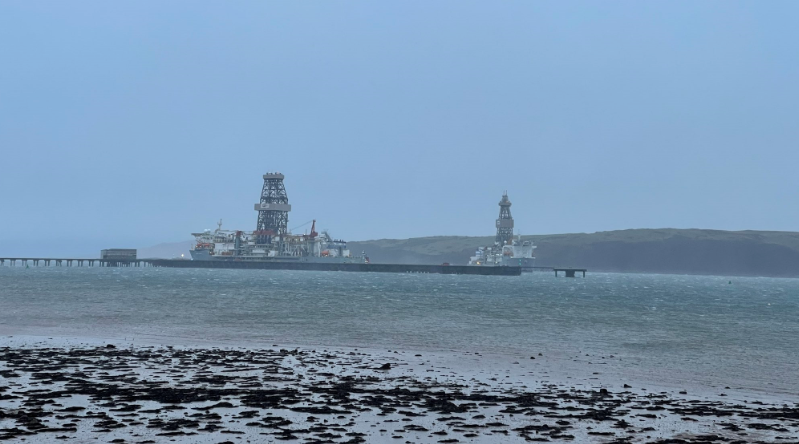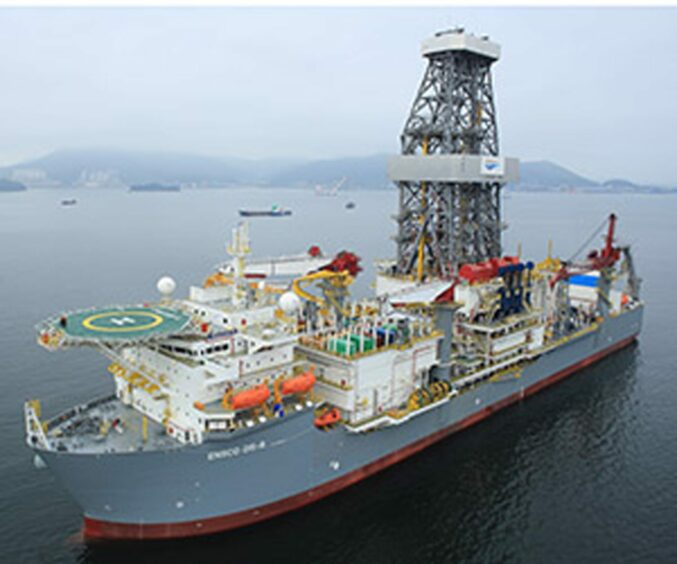
The findings of an investigation into how a drillship broke free from its moorings in Ayrshire last year have been published.
A major rescue operation was launched in February 2021 after the Valaris DS-4 vessel got into trouble and began to drift without control in high winds in the Firth of Clyde.
The drillship, with eight crew on board, was blown off the jetty at Hunterston and floated into the Largs Channel until its anchor caught and power was restored.
If it had not been brought under control, it is likely the vessel would have run aground at Great Cumbrae Island, about 400 metres to the west, the report said.
Rescue teams were also called out to assist the nearby Valaris DS-8 drillship – it remained moored alongside the jetty with tug assistance and the use of its thruster.
An investigation into the sequence of events that led to the vessels getting into trouble was subsequently launched by the Marine Accident Investigation Branch.
And the findings of the study, including recommendations, have now been compiled into a 43-page report.
As part of a number of suggestions, Joulon Asset Management, contracted to prepare for the lay-up of the vessel, and Noah Ship Management, technical manager of the DS-4, have been encouraged to “review and revise their procedures for planning for vessel lay-ups” and to learn the lessons of what happened to the Valaris vessel.
Meanwhile, Peel Ports, operator of the Hunterston Terminal, is being recommended to draw up guidance on planning and conducting of vessel lay-up in ports in the UK.
That will then go to the Maritime and Coastguard Agency (MCA) for inclusion in the Port Marine Safety Code’s guide to good practice.
Gary Doyle, group harbour master, Peel Ports said: “Clydeport Operations both welcomes and supports the investigation into the event at Hunterston on February 2nd 2021.
“We note the conclusions and recommendations and we are confident that as Statutory Harbour Authority, our procedures were adequate throughout.
“If required, we are content to share these procedures with the MCA for consideration and adoption nationally.”
How it panned out
The Valaris DS-4 and Valaris DS-8, both of which are registered in the Marsahll Islands, arrived at Hunterston Jetty on December 27 and 28 respectively.
Prior to their departure from Gran Canaria, where they had been warm stacked ready for reactivation, Noah and Joulon drew up weather contingency and emergency response plans.
During their transit, concerns about both drillships’ mooring plans and the impact of high wind speeds were flagged, the report said.
Hunterston Jetty is located at the southern end of the Clyde Estuary, on the Largs Channel, between Great Cumbrae Island and the Scottish mainland.
A few weeks before the major incident, the Valaris DS-4 partially lost her mooring during bad weather, and the decision was subsequently taken to shift both vessels to the south-west.
Then, on February 2, the 750-foot long vessel lost its moorings entirely.
Only some luck, some brave individuals and a tug has stopped a drill ship heading over towards the nuclear intake cooling pipe at Hunterston @FriendsClyde @FairlieCoastal pic.twitter.com/HhS5kh2rQE
— david nairn (@ClydePorpoise) February 2, 2021
Wind speeds on the west coast increased throughout the course of the day and by the evening they had reached as much as 55 knots.
At about 7.15pm, by which time wind speeds had reached 70kn, the DS-4’s moorings failed and the vessel was blown off the jetty into the channel, sparking a major rescue operation.
Efforts were taken to start the diesel generators to get the thrusters up and running, but they failed and the vessel broadcast a mayday for help.
Based on AIS information, at about 7.23pm the anchor held.
By this time, the DS-4 had drifted approximately halfway across the channel between the jetty and Great Cumbrae Island.
If the anchor, which had previously been deployed as part of the vessel’s mooring arrangements, hadn’t stepped in, it’s likely the ship would have gone aground on Great Cumbrae, the report said.
In anticipation of this, the MCA had mobilised equipment for a Tier 3 oil spill.
At around the same time, the master of the DS-8 requested tug assistance, and four were dispatched to help the vessel over the next few hours.
The Valaris DS-4 remained at anchor halfway across the channel and, by noon on February 3, most of the diesel generators were active.
One failed to start however, and the vessel remained where it was while technicians worked to identify the problem, while tugs pushed on the boat to ease pressure on the anchor.
A few days later, on February 7, most of the issue were resolved, and it was moored alongside the jetty again the following day.
The report identified a host of conclusions based on the findings, including two causal factors that contributed to the incident.
They are the inability of Valaris DS-4’s crewmembers to bring the thrusters online in time to prevent the mooring lines from being overloaded by the gales.
It also highlighted that the master of the vessel did not request tug assistance when the weather forecast for storm force winds was received on February 2.
Numerous actions that have subsequently been taken by Joulon and Noah in response to the incident have also been set out.
The MCA’s marine safety investigation is closed and will only be reopened if additional information is received that would warrant further review.
Valaris, Noah and Joulon were all approached for comment.


 © Supplied by Valaris
© Supplied by Valaris